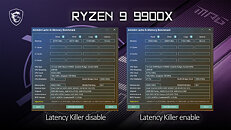- Joined
- Aug 19, 2017
- Messages
- 2,915 (1.05/day)
MSI has unveiled a new performance-enhancing feature for its AM5 socket motherboards to improve DDR5 memory latency. Some latency issues that emerged following AMD's AGESA 1.2.0.2a microcode update, which added support for AMD's Ryzen 9000X3D processors, are now fixed. MSI has baked in its BIOS tuning to develop a new "Latency Killer" feature, which can be found in the advanced menu section, specifically within the overclocking submenu in BIOS of MSI X870E/X870 gaming motherboards like MEG X870E GODLIKE and MPG X870E CARBON WIFI. Users have three options to choose from: Auto, Enabled, and Disabled. While the default behavior of the Auto setting remains unclear, it is believed to be initially disabled to ensure system stability.
Recent benchmark testing of Uniko's Hardware using AIDA64 has demonstrated promising results, showing an eight nanosecond improvement in memory latency when the new feature is activated. The test was conducted using a Ryzen 7 9800X3D processor paired with an MPG X870E Carbon WiFi motherboard and DDR5-8000 CL38 memory, running in High-Efficiency mode at its maximum preset. Some Reddit users with AMD Ryzen 7 9800X3D on MSI Tomahawk X870 reported seeing 10-12 ns improvement from enabling the "Latency Killer." MSI motherboards complement its Latency Killer feature with additional memory optimization tools in the BIOS, including EXPO / A-XMP profiles, Memory Try It presets, High-Efficiency Mode, and comprehensive manual overclocking options for enthusiasts seeking maximum performance.




However, MSI has noted potential trade-offs with the feature. According to the BIOS description, while the Latency Killer enhances memory latency performance, it may impact overall CPU performance. The feature restores memory latency to levels seen before AGESA 1.2.0.2a microcode update rather than providing magical improvements. This way, users don't have to flash their systems with older AGESA BIOS versions. For most users, particularly those with X3D-equipped Ryzen processors featuring 96 MB L3 cache, the few nanosecond latency differences will help during regular usage, including gaming. The enhancement primarily targets enthusiast users and extreme overclockers who prioritize maximum system performance. MSI stated that all MSI AM5 series motherboards are now getting this feature, and it works with all Ryzen 9000 series processors
View at TechPowerUp Main Site | Source
Recent benchmark testing of Uniko's Hardware using AIDA64 has demonstrated promising results, showing an eight nanosecond improvement in memory latency when the new feature is activated. The test was conducted using a Ryzen 7 9800X3D processor paired with an MPG X870E Carbon WiFi motherboard and DDR5-8000 CL38 memory, running in High-Efficiency mode at its maximum preset. Some Reddit users with AMD Ryzen 7 9800X3D on MSI Tomahawk X870 reported seeing 10-12 ns improvement from enabling the "Latency Killer." MSI motherboards complement its Latency Killer feature with additional memory optimization tools in the BIOS, including EXPO / A-XMP profiles, Memory Try It presets, High-Efficiency Mode, and comprehensive manual overclocking options for enthusiasts seeking maximum performance.




However, MSI has noted potential trade-offs with the feature. According to the BIOS description, while the Latency Killer enhances memory latency performance, it may impact overall CPU performance. The feature restores memory latency to levels seen before AGESA 1.2.0.2a microcode update rather than providing magical improvements. This way, users don't have to flash their systems with older AGESA BIOS versions. For most users, particularly those with X3D-equipped Ryzen processors featuring 96 MB L3 cache, the few nanosecond latency differences will help during regular usage, including gaming. The enhancement primarily targets enthusiast users and extreme overclockers who prioritize maximum system performance. MSI stated that all MSI AM5 series motherboards are now getting this feature, and it works with all Ryzen 9000 series processors
View at TechPowerUp Main Site | Source




